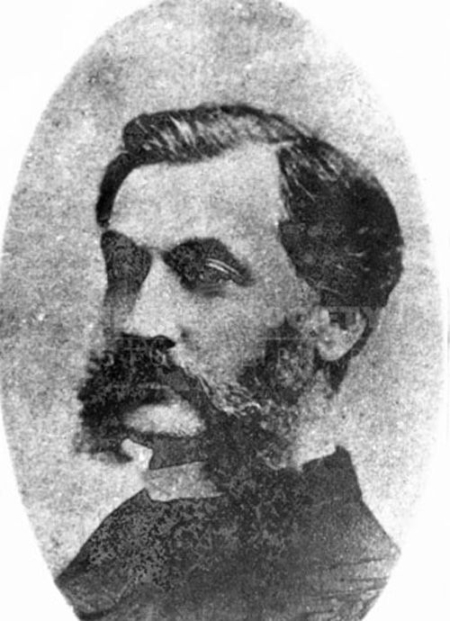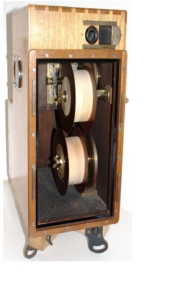The Life, Mystery and Legacy of Louis Le Prince
Louis Le Prince, an influential but often overlooked figure in the history of film, was a French artist and inventor who developed the first motion-picture camera and possibly shot the world’s earliest motion picture sequence using a single-lens camera with a strip of film. While he is now regarded as the "Father of Cinematography," he remained largely forgotten until recent years.
Early Life
 Louis Aimé Augustin Le Prince was born on August 28, 1841, in Metz, France, at 13 Rue Saint Georges. The street remains in the old part of town, though it bears no plaque commemorating Le Prince, whose groundbreaking invention predated those of Thomas Edison and the Lumière brothers by several years. Le Prince was the son of Abraham Ambroise Louis Le Prince, a captain in the Seventh Regiment of Artillery, and a close friend of Louis Daguerre, an early pioneer of photography. As a young boy, Le Prince likely spent time in Daguerre’s studio, possibly receiving lessons in photography and chemistry, sparking his own inventive drive.
Louis Aimé Augustin Le Prince was born on August 28, 1841, in Metz, France, at 13 Rue Saint Georges. The street remains in the old part of town, though it bears no plaque commemorating Le Prince, whose groundbreaking invention predated those of Thomas Edison and the Lumière brothers by several years. Le Prince was the son of Abraham Ambroise Louis Le Prince, a captain in the Seventh Regiment of Artillery, and a close friend of Louis Daguerre, an early pioneer of photography. As a young boy, Le Prince likely spent time in Daguerre’s studio, possibly receiving lessons in photography and chemistry, sparking his own inventive drive.
Le Prince went on to study physics and chemistry in Paris, Bonn, and Leipzig, earning a Bachelor of Science at the Lycée Saint-Louis in Paris. During his studies, he befriended John Robinson Whitley, an Englishman who later invited Le Prince to join his father’s engineering foundry as a partner.
Early Years in Leeds
 In 1866, Le Prince moved to Leeds, England, joining Whitley’s family business, Whitley Partners, and represented them and other Leeds industries at the 1867 Universal Exhibition in Paris. In 1869, Le Prince married Whitley’s sister, Elizabeth, an accomplished artist. The couple shared an interest in the arts, frequently attending magic shows and visual spectacles, which fostered Le Prince’s fascination with moving images.
In 1866, Le Prince moved to Leeds, England, joining Whitley’s family business, Whitley Partners, and represented them and other Leeds industries at the 1867 Universal Exhibition in Paris. In 1869, Le Prince married Whitley’s sister, Elizabeth, an accomplished artist. The couple shared an interest in the arts, frequently attending magic shows and visual spectacles, which fostered Le Prince’s fascination with moving images.
In 1874, after passing the required exams to teach in England, Le Prince and his wife opened The School of Applied Arts at 33 Park Square in Leeds. The school offered practical art training, an uncommon approach at the time, and earned significant recognition. Around this time, Le Prince also began experimenting with new methods of firing glazes and paints on ceramics and developed a technique for reproducing photographs on enamels, ceramics, and metals. His work was noticed by members of British royalty, and his portraits of Queen Victoria and William Gladstone were preserved in a time capsule within London’s Cleopatra’s Needle.
The Invention
 By the late 1880s, Le Prince was fully focused on his camera technology. Initially, he designed a camera with sixteen lenses, though he soon turned his attention to a more practical, single-lens version. In October 1888, Le Prince used his single-lens camera to shoot what is now known as the Roundhay Garden Scene, capturing a few seconds of moving images. Later, he filmed traffic and pedestrians crossing Leeds Bridge, a location now marked by a commemorative plaque. This is thought to be the first motion picture captured.
By the late 1880s, Le Prince was fully focused on his camera technology. Initially, he designed a camera with sixteen lenses, though he soon turned his attention to a more practical, single-lens version. In October 1888, Le Prince used his single-lens camera to shoot what is now known as the Roundhay Garden Scene, capturing a few seconds of moving images. Later, he filmed traffic and pedestrians crossing Leeds Bridge, a location now marked by a commemorative plaque. This is thought to be the first motion picture captured.
Disappearance
In September 1890, Le Prince planned to travel to the United States to publicly debut his invention, intending to join his wife and children there. Before leaving, he visited his brother in Dijon, France. On September 16, he took a train to Paris but never arrived. Despite extensive searches by French police, Scotland Yard, and his family, Le Prince was never seen again, and he was legally declared dead in 1897.
Later Recognition
Despite Le Prince’s pioneering work in cinematography, his disappearance and lack of public exhibition led to him being largely forgotten until the 1920s. In 1930, Leeds honored him with a memorial tablet at his former workshop on Woodhouse Lane, and the University of Leeds named its Centre for Cinema, Photography and Television after him in 2003. Today, his legacy as an innovator is celebrated in Leeds, where he is remembered as a local hero and dubbed as the 'Father of Cinematograhy'.
You can discover more about motion picture in Leeds at Leeds Industrial Musuem.
